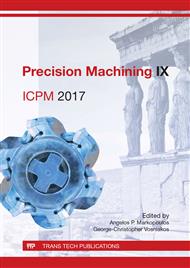p.313
p.321
p.331
p.339
p.347
p.354
p.362
p.370
p.378
FEA-Based Comparative Investigation on High Speed Machining of Aluminum Alloys AA6061-T6 and AA7075-T651
Abstract:
Independent research studies have shown notable dissimilarity in the machining behaviour of aluminum alloys AA6061−T6 and AA7075−T651 commonly used in automotive and aeronautical applications. The present work attempts to investigate this dissimilarity based on experimental and numerical data with a focus on chip formation and generated residual stresses under similar high−speed machining (HSM) conditions. The numerical data were calculated by a finite element modeling (FEM) developed using DeformTM 2D software. The results showed that both studied alloys exhibit different chip formation mechanisms and residual stress states at the machined surfaces. On one hand, the AA6061−T6 alloy generates continuous chips and tensile residual stresses whereas the AA7075−T651 alloy produces segmented chips and compressive residual stresses. FEM results showed that the AA6061−T6 alloy generates lower cutting temperature at the tool−chip interface along with higher equivalent total strains at the machined surface as compared to the AA7075−T651 alloy. Based on the experimental and numerical results, it was pointed out that the differences in terms of thermal conductivity and initial yield stress are the main reasons explaining the dissimilarity observed.
Info:
Periodical:
Pages:
347-353
Citation:
Online since:
August 2017
Authors:
Price:
Сopyright:
© 2017 Trans Tech Publications Ltd. All Rights Reserved
Share:
Citation:


